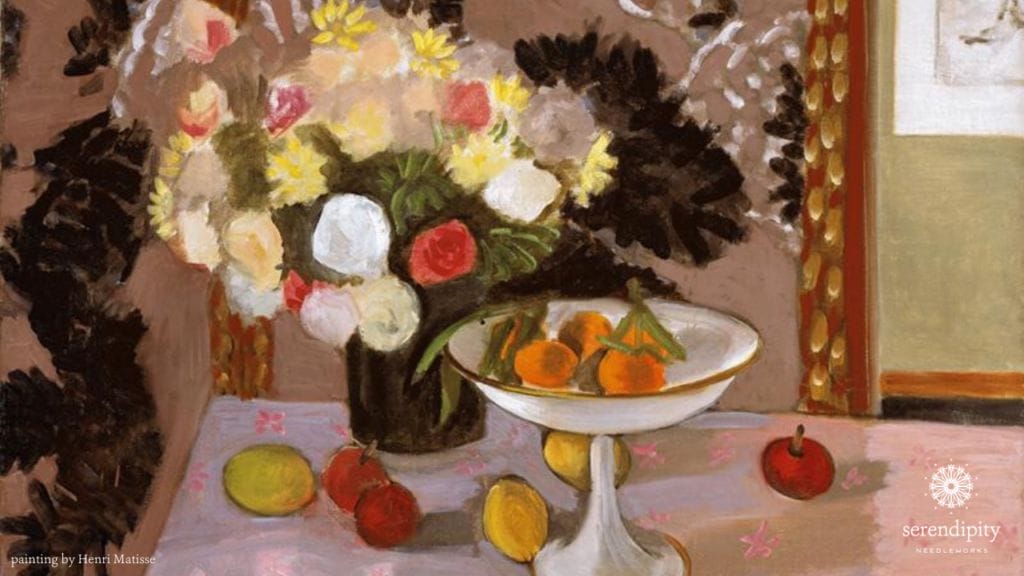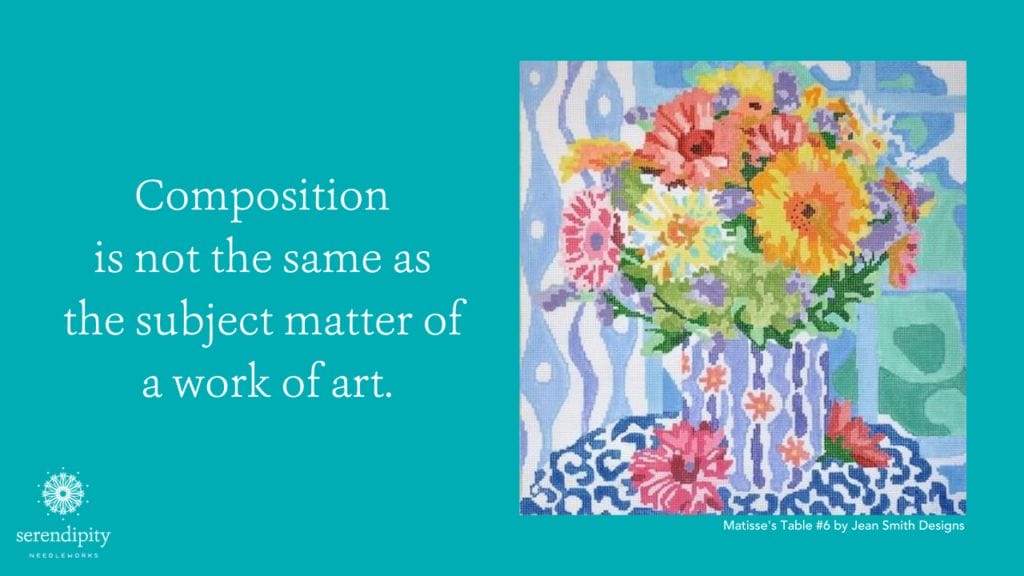Do you know that a canvas designer uses the very same elements and principles of art and design on cotton mono canvas that a painter might use on one of their watercolor or oil compositions? In fact, your hand-painted needlepoint canvas is, first and foremost, a piece of art. But what does that have to do with your needlepoint hobby?
Actually, quite a lot!
You see, I believe that it’s very important for you to understand how these things work together in a composition…
so that you can transform a two-dimensional painted needlepoint canvas into a three-dimensional piece of fiber art. And, after all, that’s what you’re doing when you use canvas embroidery stitches to add depth, dimension, and visual interest to your projects.
Let’s begin by taking a quick inventory of just exactly what the elements of art and design are…
- line
- shape
- color
- value
- texture
- form
- space
And those elements are organized according to the principles of art and design…
- balance
- contrast
- emphasis
- movement
- pattern
- rhythm
- unity/variety
plus the other elements of composition.
There’s that word again… composition! I think the French artist Henri Matisse hit the nail on the head in his definition of composition.

According to Matisse, “composition” describes the arrangement of the visual elements in a painting (or other artwork) to give the painting structure and convey the intent of the artist.
Every work of art, whether it’s an oil painting or a needlepoint canvas, has composition.
And good composition is essential to the success of any work of art. In fact, a successful composition draws the viewer into the work and then moves the viewer’s eyes across the whole work so that everything is taken in, finally settling on the main subject.
Now, let’s look at our Jean Smith canvas again…
and this time, we’ll take a peek at the elements of composition in art and how they come together to create a structure for the layout of the overall design.
First, there’s unity.
Do all of the parts of this composition (i.e., Matisse’s Table #6) seem to belong together? Or does something seem out of place? Unity establishes an overall cohesiveness to the design and yes, this design has unity.
Next, is balance.
Balance is the sense that the canvas “feels” right – that it’s not heavier on one side. When a design doesn’t have balance, it creates a sense of uneasiness. And there are different types of balance. The two that you’re probably most familiar with are symmetrical and asymmetrical. Symmetrical balance evokes a sense of calm, while asymmetrical balance creates a more dynamic feeling. This canvas conveys a sense of calm to me and it has symmetrical balance.
And there’s movement.
The arrangement of objects, as you see in Jean’s placement of the two flower heads at the base of the vase, actually adds a sense of movement to the overall design. And there’s also the use of line (one of the elements of art) that direct the viewer’s eyes into and around the work. Lines can be actual lines, like the lines of the window frame on our canvas. But they can also be implied lines like the swirls you see on the tablecloth under the vase.
A work of art can also have rhythm…
just like a piece of music. To identify the “rhythm” of a needlepoint canvas, look for the large underlying shapes (circles, rectangles, etc.) and repetition of color that leads your eyes to take in the overall composition at a certain pace. Pretty cool, huh?!
Of course, there’s always going to be a focus – or focal point.
The focal point of our canvas is definitely the bouquet of flowers. It’s the most important thing in the design. It’s where I would focus the majority of my attention when choosing stitches and threads with which to stitch this design.
Additionally, there are the artistic elements of contrast and pattern.
Contrast can be the difference between light and dark, but it can also be differences in shape, color, size, and texture. For example, this needlepoint canvas has a variety of contrasting features. There’s a nice contrast between light and dark – and there’s also good contrast in shape, color, and size. And that segues us right into pattern – the regular repetition of lines, shapes, colors, or values in a composition. We’ll talk more about these in today’s episode of Needlepoint TV. I hope you’ll join me at 3:00 p.m. CST over on the Serendipity Needleworks Facebook page.
Finally, there’s proportion.
Proportion is how things fit together and relate to each other in regard to size and scale. And the design components (or objects) that you see in the composition, Matisse’s Table #6, are proportional. In other words, the flowers in the vase are of the right size to fit into the vase and the vase isn’t too large or too small for the table that it’s sitting upon.
Alrighty – are you still with me?
I get that all of this may seem like a lot of artsy gobbledygook. But I promise you, it really will help you choose the best stitches and threads for your needlepoint projects when you look at your needlepoint canvases as pieces of art. You’ll be able to see things from a new perspective. You’ll be able to connect the dots between your painted canvas and the piece of fiber art that you desire to create. And you’ll begin to stitch with more confidence than ever before.
Well, my friend, that’s all for this week.
I hope you’ll join me for another fun-filled episode of Needlepoint TV this afternoon at 3:00 p.m. CST. And if you happen to miss the live broadcast, you can always watch the recording on the Serendipity Needleworks YouTube channel.
Until next time, happy stitching!
XOXO!

PS: This is my first post in a series of 2020 blog posts where I’ll share bits and pieces of my carefully curated framework for learning to create your very own custom stitch guides for your needlepoint projects. I’m over-the-moon excited about it and I hope you’ll sign up to get my weekly emails so you don’t miss anything!






Thank you for this email. I see a new way to look at needlework and I just love it. So thankful that you do this and it is free. You are sharing your precious past with us. It is filled with so much knowledge. Allene Peek Vashti, Texas
Awww… thank you so much for your kind words, Allene! It’s a joy to be able to share my love of needlepoint with y’all. 🙂
I’m tickled that you’re enjoying it as much as I am.
XOXO!
Ellen